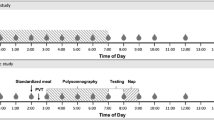Abstract
In human volunteers who have been continuously experiencing unsatisfactory sleep, effects of glycine ingestion (3 g) before bedtime on subjective sleep quality were investigated, and changes in polysomnography (PSG) during sleep were analyzed. Effects on daytime sleepiness and daytime cognitive function were also evaluated. Glycine improved subjective sleep quality and sleep efficacy (sleep time/in-bed time), and shortened PSG latency both to sleep onset and to slow wave sleep without changes in the sleep architecture. Glycine lessened daytime sleepiness and improved performance of memory recognition tasks. Thus, a bolus ingestion of glycine before bedtime seems to produce subjective and objective improvement of the sleep quality in a different way than traditional hypnotic drugs such as benzodiazepines.
Similar content being viewed by others
References
Inagawa K, Hiraoka T, Kohda T, Yamadera W, Takahashi M. Subjective effects of glycine ingestion before bedtime on sleep quality. Sleep Biol. Rhythms 2006; 4: 75–7.
Inagawa K, Kawai N, Ono K, Sukegawa E, Tsubuku S, Takahashi M. Assessment of acute adverse events of glycine ingestion at high doses in human volunteers. J. Urban Life Health Assoc. 2006; 50: 27–32.
Buysse DJ, Reynolds CF III, Monk TH, Berman SR, Kupfer DJ. The Pittsburgh Sleep Quality Index: a new instrument for psychiatric practice and research. Psychiatr. Res. 1989; 29: 193–213.
Doi Y, Minowa M, Uchiyama M, Okawa M. Development of the Pittsburgh Sleep Quality Index Japanese Version. Jpn J. Psychiatr. Treat. 1998; 13: 755–68 (in Japanese).
Ellis BW, Johns MW, Lancaster R, Raptopoulos P, Angelopolos N, Pereist RG. The St. Mary’s Hospital sleep questionnaire: a study of reliability. Sleep 1981; 4: 93–7.
Uchiyama M, Ohta K, Okawa M. [Evaluation standards of sleep and sleep disorder.] In: Matsushita M, ed. [Encyclopedia of Clinical Psychiatry, Vol. 13, Sleep Disorder.] Tokyo: Nakayama Shoten, 1999; 489–98 (in Japanese).
Rechtschaffen A, Kales A. A Manual of Standardized Terminology, Techniques and Scoring System for Sleep Stages of Human Subjects. Washington, DC: Public Health Service, US Government Printing Office, 1968.
Hoddes E, Zarcone V, Smythe H, Phillips R. Quantification of sleepiness: a new approach. Psychophysiology 1973; 10: 431–6.
Monk TH. A visual analogue scale technique to measure global vigor and affect. Psychiatr. Res. 1989; 27: 89–99.
Monti JM. Sleep laboratory and clinical studies of the effects of triazolam, flnitrazoram and flurazepam in insomniac patients. Methods Find. Exp. Clin. Pharmacol. 1981; 3: 303–26.
Parrino I, Terzano MG. Polysomnographic effects of hypnotics: a review. Psychopharmacology 1996; 126: 1–16.
Roth T, Roehrs TA. A review of the safety profiles of benzodiazepine hypnotics. J. Clin. Psychiatry 1991; 52.
Holbrook AM, Crowther R, Lotter A, Cheng C, King D. Meta-analysis of benzodiazepines use in the treatment of insomnia. Can. Med. Assoc. J. 2000; 162: 225–33.
Roehrs TA, Merlotti L, Zorick F, Roth T. Sedative, memory, and performance effects of hypnotics. Psychopharmacology 1994; 116: 130–4.
Seki S, Ono-Takesue K, Yoshida S, Inagawa K, Murakami N, Takahashi M. Accumulation of peripheral glycine in the pineal body. Bull. Jpn Soc. Neurochem. 2004; 43: 558.
Author information
Authors and Affiliations
Corresponding author
Rights and permissions
About this article
Cite this article
Yamadera, W., Inagawa, K., Chiba, S. et al. Glycine ingestion improves subjective sleep quality in human volunteers, correlating with polysomnographic changes. Sleep Biol. Rhythms 5, 126–131 (2007). https://doi.org/10.1111/j.1479-8425.2007.00262.x
Accepted:
Published:
Issue Date:
DOI: https://doi.org/10.1111/j.1479-8425.2007.00262.x




